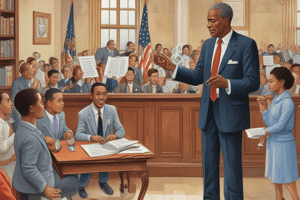Podcast
Questions and Answers
What is the Lemon Test used for?
What is the Lemon Test used for?
The Lemon Test is a three-part test used to determine issues related to the Establishment Clause of the First Amendment.
Explain the difference between believing and acting on a religious belief according to the Free Exercise Clause.
Explain the difference between believing and acting on a religious belief according to the Free Exercise Clause.
The Free Exercise Clause allows individuals to believe in any religion, but the government can regulate the actions taken based on those beliefs.
What type of speech does sedition refer to?
What type of speech does sedition refer to?
Sedition refers to speech that advocates for the overthrow or violent disruption of lawful government activities.
Define slander and libel.
Define slander and libel.
What are shield laws, and at what level do they exist?
What are shield laws, and at what level do they exist?
What constitutes prior restraint in terms of freedom of speech?
What constitutes prior restraint in terms of freedom of speech?
What criteria are used to determine if something is obscene?
What criteria are used to determine if something is obscene?
What is the right of petition, and how can individuals exercise it?
What is the right of petition, and how can individuals exercise it?
What are civil liberties and where are they primarily found in the United States?
What are civil liberties and where are they primarily found in the United States?
How do civil rights differ from civil liberties?
How do civil rights differ from civil liberties?
Explain the relativity of rights in the context of individual freedoms.
Explain the relativity of rights in the context of individual freedoms.
What limitations can schools impose on student rights, and why?
What limitations can schools impose on student rights, and why?
What does 'in loco parentis' mean in the context of schools?
What does 'in loco parentis' mean in the context of schools?
Identify the five parts of the First Amendment using the mnemonic device.
Identify the five parts of the First Amendment using the mnemonic device.
What is the Establishment Clause and who is associated with its interpretation?
What is the Establishment Clause and who is associated with its interpretation?
What was the significance of the Supreme Court case Lemon v. Kurtzman?
What was the significance of the Supreme Court case Lemon v. Kurtzman?
Flashcards are hidden until you start studying
Study Notes
Civil Liberties vs. Civil Rights
- Civil Liberties: Protections citizens have from government overreach, primarily outlined in the Bill of Rights.
- Civil Rights: Government actions intended to protect and ensure civil liberties for all individuals, including non-citizens.
- Examples include executive actions, legislative measures, and judicial rulings that safeguard rights.
Relativity of Rights
- Rights in the U.S. are not absolute; they are relative to the rights of others.
- Quote by Oliver Wendell Holmes: "The right to swing my fist ends where the other person’s nose begins."
Limitations of Rights in School
- Disruption of the Learning Environment: Students' rights can be limited if their actions or expressions disrupt education (e.g., dress codes).
- School Safety: Schools must ensure student safety; staff can act based on reasonable suspicion, while police need probable cause.
- In Loco Parentis: School officials assume parental responsibilities, allowing them to intervene in situations impacting the school environment.
- Due Process: All students are entitled to due process rights, ensuring fair treatment.
First Amendment
- Comprised of five key components: Religion, Assembly, Press, Petition, and Speech.
- Protects minority and unpopular opinions, serving as a cornerstone of free expression.
Freedom of Religion
- Establishment Clause: Prohibits government from establishing or favoring any religion; supported by Jefferson's "wall of separation."
- Lemon v. Kurtzman: Introduced the Lemon Test to assess if government actions violate the Establishment Clause.
- Free Exercise Clause: Ensures individual's rights to religious beliefs but allows government regulation of practices, except in long-standing traditions (e.g., Wisconsin v. Yoder).
Freedom of Speech and Press
- Slander: Spoken false statements intended to harm others; Libel: Written equivalent.
- Key Defense: Truth serves as a primary defense against libel claims.
- Sedition: Illegal speech advocating for the violent overthrow of government or disruption of lawful activities.
- Shield Laws: Protect journalists from disclosing their sources in state jurisdictions but not nationally.
Freedom of Speech and Press Cont.
- Prior Restraint: Government cannot censor ideas before they are expressed.
- Obscenity Test: Material can be deemed obscene if it violates community standards and lacks artistic value.
- Symbolic Speech: Non-verbal expressions, such as flag burning or wearing armbands, are protected forms of speech.
Rights of Assembly and Petition
- Right of Assembly: Individuals can gather peacefully; reasonable regulations on time, place, and manner are permissible.
- Government cannot restrict the identity of groups wishing to assemble or the subject of their assemblies.
- Right of Petition: Citizens can contact government officials with concerns; any communication is significant, representing broader public sentiment.
Studying That Suits You
Use AI to generate personalized quizzes and flashcards to suit your learning preferences.




